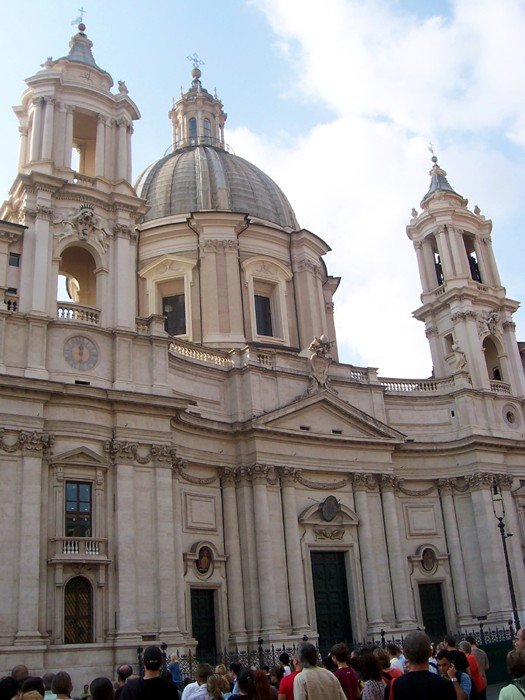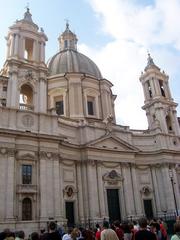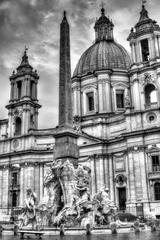
Sant’Agnese in Agone: Visiting Hours, Tickets, and Complete History Guide – Rome, Italy
Date: 14/06/2025
Introduction: Sant’Agnese in Agone’s Historical and Cultural Significance
Sant’Agnese in Agone is a jewel of Baroque Rome, harmoniously blending faith, history, and artistic excellence. Located on the west side of Piazza Navona, this church is intimately intertwined with the story of Saint Agnes, a young Christian martyr who became a symbol of purity and courage. The church’s name, drawn from the Greek “agōn” meaning “contest,” reflects the site’s origins as the Stadium of Domitian, where athletic competitions once took place. Today, Sant’Agnese in Agone is not only an architectural marvel but also a spiritual and cultural touchstone for visitors to Rome (Sant’Agnese in Agone Official Site; Turismo Roma).
Commissioned in 1652 by Pope Innocent X Pamphilj, the church is a showcase of Baroque artistry, with contributions from leading architects like Girolamo and Carlo Rainaldi, Francesco Borromini, and Gian Lorenzo Bernini. Its innovative façade, soaring dome, and richly decorated chapels provide a vivid narrative of Rome’s religious and artistic evolution (Wikipedia; churches-of-rome.info).
This guide offers an in-depth look at the church’s history, architecture, artistic treasures, and practical visiting information, including hours, ticketing, accessibility, and nearby attractions—making it an essential resource for anyone exploring Rome historical sites.
Table of Contents
- Introduction
- Origins and Early Christian Significance
- The Name “In Agone” and Piazza Navona
- Baroque Transformation: Patronage and Architectural Rivalry
- Construction and Further Modifications
- Interior Art and Architecture
- Visitor Information: Hours, Tickets, Accessibility, and Tours
- Nearby Attractions and Travel Tips
- Frequently Asked Questions (FAQ)
- Conclusion
- Sources and Further Reading
Origins and Early Christian Significance
Sant’Agnese in Agone is built on a site rich in history—once the Stadium of Domitian, where Saint Agnes purportedly suffered martyrdom after refusing to renounce her faith. According to tradition, her modesty was miraculously preserved, and the location of her ordeal became a focus for Christian veneration (Turismo Roma). A church has existed here since at least the 7th century CE, evolving over centuries as a place of pilgrimage (Sant’Agnese in Agone Official Site).
The Name: “In Agone” and Piazza Navona
The title “Sant’Agnese in Agone” refers not to suffering, but to the Greek word for “contest,” honoring the stadium’s athletic past. “Piazza in Agone” gradually became “Navona,” reflecting the continuity of Rome’s pagan, imperial, and Christian traditions (Wikipedia).
Baroque Transformation: Patronage and Architectural Rivalry
Rainaldi’s Initial Designs
In 1652, Pope Innocent X Pamphilj initiated the construction of a grand new church to enhance his family’s influence and the urban spectacle of Piazza Navona. Girolamo Rainaldi and his son Carlo conceived a Greek cross plan with an imposing façade facing the piazza. Their design included a narthex, twin bell towers, and a staircase projecting toward the square (Wikipedia).
Borromini’s Innovations
Francesco Borromini took over in 1653, radically reimagining the façade with a dramatic concave form that draws the viewer’s eye inward. He improved the dome’s supports and introduced structural and aesthetic elements that became models for Baroque architecture in northern Europe. The façade’s interplay of curves, columns, and twin towers creates a dynamic dialogue with the piazza (Turismo Roma).
Interaction with Bernini
Sant’Agnese in Agone’s history is inseparable from its relationship with Gian Lorenzo Bernini, whose Fountain of the Four Rivers stands directly before the church. While legends of rivalry abound, the proximity of these masterpieces underscores the intense artistic competition and innovation of Baroque Rome (Wikipedia).
Construction and Further Modifications
Following Pope Innocent X’s death, the project saw interruptions and changes in leadership. Borromini’s resignation led to Carlo Rainaldi’s return, who modified the façade and eliminated the narthex. Bernini contributed to the completion of the façade and interior decoration, finalizing the project by 1672 (churches-of-rome.info).
Interior Art and Architecture
Plan and Dome
The church features a Greek cross plan, with a central dome supported by pendentives and illuminated by natural light. The interior is designed to draw visitors’ eyes upward, creating a sense of awe (churches-of-rome.info).
Artistic Highlights
- Main Altar and Crypt: Alessandro Algardi designed the altar of the crypt, featuring a marble relief of the “Miracle of the Hair of Sant’Agnese.” The crypt is traditionally considered the site of Agnes’s martyrdom and houses her relics (artandtraditiontours.com).
- Frescoes: The dome and pendentives are adorned with frescoes by Ciro Ferri, Sebastiano Corbellini, Giovanni Battista Gaulli, and others, depicting scenes from the life of Saint Agnes and the Cardinal Virtues.
- Chapels: The Chapel of St Francesca Romana contains the baptismal font from the earlier church, flanked by angels by Andrea Bolgi. Sculptures by Melchiorre Cafà and Ercole Ferrata enrich the chapels (santagneseinagone.org).
Visitor Information: Hours, Tickets, Accessibility, and Tours
Visiting Hours
- Weekdays (except Monday): 9:00 a.m. – 1:00 p.m. and 3:00 p.m. – 7:00 p.m.
- Saturday and Sunday: 9:00 a.m. – 1:00 p.m. and 3:00 p.m. – 8:00 p.m.
- Closed on Mondays (Sant’Agnese in Agone official site)
Tickets and Entry
Admission is free for individual visitors. Donations are encouraged. Special exhibitions, concerts, or crypt tours may require tickets or reservations (TripHobo).
Accessibility
The main church is accessible to visitors with limited mobility via ramps at the entrance. Some chapels and the crypt may offer limited access. For specific needs, contact the church in advance (Sant’Agnese in Agone official site).
Guided Tours and Events
Guided tours are available through local operators or on special occasions. The church regularly hosts concerts, particularly in the restored Borromini Sacristy. Check the official website for schedules and ticketing (romesightseeing.net).
Nearby Attractions and Travel Tips
- Piazza Navona: Features Bernini’s Fountain of the Four Rivers and lively street artists.
- Palazzo Pamphilj: Adjacent to the church, with historic rooms and a rooftop café.
- Pantheon and Campo de’ Fiori: Both within a 10-minute walk.
- Transportation: Nearest Metro stations are Barberini (Line A) and Colosseo (Line B), about a 20–25 minute walk. City buses stop at Largo di Torre Argentina (Rome Toolkit).
- Best Times to Visit: Early morning or late afternoon for fewer crowds and the best light for photography.
Frequently Asked Questions (FAQ)
Q: What are Sant’Agnese in Agone’s visiting hours?
A: Weekdays (except Monday): 9:00 a.m. – 1:00 p.m., 3:00 p.m. – 7:00 p.m. Saturday and Sunday until 8:00 p.m. Closed Monday.
Q: Is there an entrance fee or tickets?
A: Entry is free. Donations are welcome. Some events or tours may require tickets.
Q: Is the church accessible for disabled visitors?
A: The main entrance and nave are accessible; some areas may have limited access.
Q: Can I take photos inside?
A: Non-flash photography for personal use is allowed; professional equipment requires permission.
Q: How do I reach Sant’Agnese in Agone by public transport?
A: Use city buses to Largo di Torre Argentina, then walk. Metro stations are about 20–25 minutes away.
Conclusion
Sant’Agnese in Agone is a quintessential Roman experience, offering a profound encounter with Baroque art, Christian devotion, and the layered history of Piazza Navona. Its free admission, central location, and rich artistic heritage make it a must-visit for travelers seeking to immerse themselves in the spirit of Rome. Enhance your visit with a guided tour, attend a concert, and explore the surrounding piazza to appreciate this unique blend of architecture, spirituality, and urban life.
For the latest information, event updates, and guided audio tours, download the Audiala app and explore our related articles on Rome’s artistic and historical treasures. Follow us on social media for more Rome travel inspiration.
Reliable Sources, Official Websites, and Further Reading
- Sant’Agnese in Agone Official Site
- Turismo Roma
- Wikipedia: Sant’Agnese in Agone
- churches-of-rome.info: Sant’Agnese in Agone Architectural Highlights
- artandtraditiontours.com: Sant’Agnese in Agone Baroque Gem
- romesightseeing.net: Sant’Agnese in Agone Visiting Information
- Rome Toolkit: Piazza Navona and Sant’Agnese in Agone
- TripHobo: Sant’Agnese in Agone Visitor Tips
- Italy Tourist Information: Piazza Navona Landmarks
Edited and optimized for clarity, structure, and SEO. For the latest updates, always refer to the official site.



















































































































































































































































